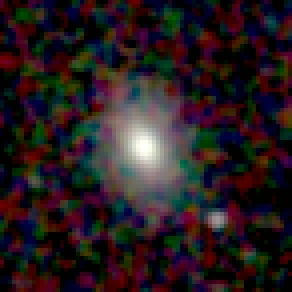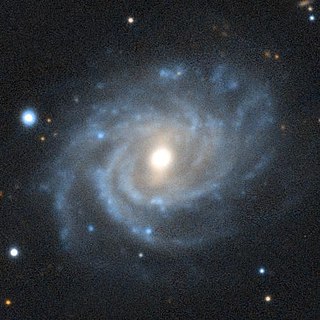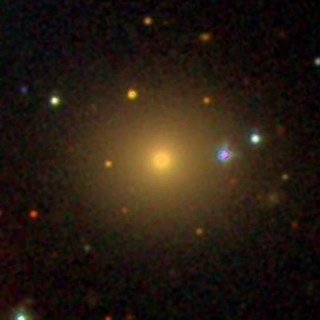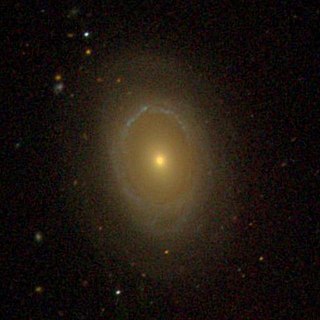
NGC 523, also known as Arp 158, from the ARP catalog is a spiral galaxy located in the constellation Andromeda. It was discovered separately by William Herschel on 13 September 1784, and by Heinrich d'Arrest on 13 August 1862. d'Arrest's discovery was listed as NGC 523, while Herschel's was listed as NGC 537; the two are one and the same. John Dreyer noted in the New General Catalogue that NGC 523 is a double nebula.

NGC 7033 is a lenticular galaxy located about 390 million light-years away in the constellation of Pegasus. It is part of a pair of galaxies that contains the nearby galaxy NGC 7034. NGC 7033 was discovered by astronomer Albert Marth on September 17, 1863.

NGC 7038 is an intermediate spiral galaxy located about 210 million light-years away in the constellation of Indus. NGC 7038 was discovered by astronomer John Herschel on September 30, 1834.

NGC 7042 is a spiral galaxy located about 210 million light-years away in the constellation of Pegasus. NGC 7042 is part of a pair of galaxies that contains the galaxy NGC 7043. Astronomer William Herschel discovered NGC 7042 on October 16, 1784.

NGC 4564 is an elliptical galaxy located about 57 million light-years away in the constellation Virgo. NGC 4564 was discovered by astronomer William Herschel on March 15, 1784. The galaxy is also a member of the Virgo Cluster.

NGC 3336 is a barred spiral galaxy located about 190 million light-years away in the constellation Hydra. It was discovered by astronomer John Herschel on March 24, 1835. NGC 3336 is a member of the Hydra Cluster.

NGC 1259 is a lenticular galaxy located about 243 million light-years away in the constellation Perseus. The galaxy was discovered by astronomer Guillaume Bigourdan on October 21, 1884 and is a member of the Perseus Cluster.

NGC 1268 is a spiral galaxy located about 140 million light-years away in the constellation Perseus. It was discovered by astronomer Heinrich d'Arrest on February 14, 1863. NGC 1268 is a member of the Perseus Cluster and appears to show signs of distortion in the form of bridges. These features may be the result of a strong interaction with NGC 1267.

NGC 1282 is an elliptical galaxy located about 230 million light-years away in the constellation Perseus. It was discovered by astronomer Guillaume Bigourdan on October 23, 1884. NGC 1282 is a member of the Perseus Cluster.

NGC 3805 is a lenticular galaxy located about 330 million light-years away in the constellation Leo. The galaxy was discovered by astronomer William Herschel on April 25, 1785. NGC 3805 is a member of the Leo Cluster.

NGC 3840 is a spiral galaxy located about 320 million light-years away in the constellation Leo. The galaxy was discovered by astronomer Heinrich d'Arrest on May 8, 1864. NGC 3840 is a member of the Leo Cluster. The galaxy is rich in neutral atomic hydrogen and is not interacting with its environment.

NGC 3851 is an elliptical or lenticular galaxy located about 300 million light-years away in the constellation Leo. It was discovered by astronomer John Herschel on February 24, 1827 and is a member of the Leo Cluster.

NGC 3859 is a spiral galaxy located about 295 million light-years away in the constellation Leo. It was discovered by astronomer Édouard Stephan on March 23, 1884. The galaxy is a member of the Leo Cluster.

NGC 3861 is a large barred spiral galaxy with a ring-like structure located about 310 million light-years away in the constellation Leo. It was discovered by astronomer John Herschel on March 23, 1827. NGC 3861 is a member of the Leo Cluster and has a normal amount of neutral hydrogen and ionised hydrogen.

NGC 3867 is a spiral galaxy located about 350 million light-years away in the constellation Leo. It was discovered by astronomer Édouard Stephan on March 23, 1884 and is a member of the Leo Cluster.

NGC 3873 is an elliptical galaxy located about 300 million light-years away in the constellation Leo. The galaxy was discovered by astronomer Heinrich d'Arrest on May 8, 1864. NGC 3873 is a member of the Leo Cluster.

NGC 3884 is a spiral galaxy located about 330 million light-years away in the constellation Leo. The galaxy was discovered by astronomer William Herschel on April 27, 1785 and is a member of the Leo Cluster.

NGC 3558 is an elliptical or a lenticular galaxy located 440 million light-years away in the constellation Ursa Major. It was discovered by the astronomer Heinrich d'Arrest on April 15, 1866. It is a member of the galaxy cluster Abell 1185 and is classified as a LINER galaxy.

NGC 4090 is a spiral galaxy located 340 million light-years away in the constellation Coma Berenices. The galaxy was discovered by astronomer Heinrich d'Arrest on May 2, 1864 and is a member of the NGC 4065 Group.

NGC 4316 is an edge-on spiral galaxy located about 70 million light-years away in the constellation Virgo. It was discovered by astronomer Wilhelm Tempel on March 17, 1882. NGC 4316 is a member of the Virgo Cluster and is classified as LINER and as a Seyfert galaxy.




















